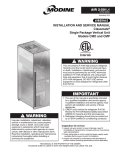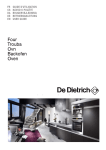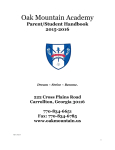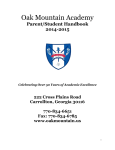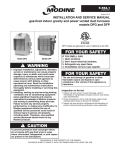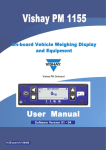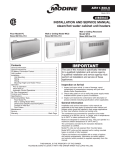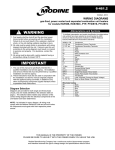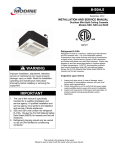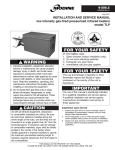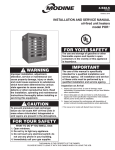Download WARNING WARNING IMPORTANT
Transcript
14-500.2 5H103442A1 January, 2014 INSTALLATION AND SERVICE MANUAL Valedictorian Vertical Unit Ventilator Models VFV, VFF, VSV, and VSF TM WARNING Improper installation, adjustment, alteration, service or maintenance can cause property damage, injury or death, and could cause exposure to substances which have been determined by various state agencies to cause cancer, birth defects or other reproductive harm. Read the installation, operating and maintenance instructions thoroughly before installing or servicing this equipment. IMPORTANT 1. The use of this manual is specifically intended for a qualified installation and service agency. A qualified installation and service agency must perform all installation and service of these appliances. 2. VFV, VFF, VSV and VSF units with DX evaporator coils contain the refrigerant R-410A. Review the R-410A Material Safety Data Sheet (MSDS) for hazards and first aid measures. 3. Refrigerant charging should only be carried out by an EPA-certified air conditioning contractor. WARNING This unit contains R-410A high pressure refrigerant. Hazards exist that could result in personal injury or death. Installation, maintenance, and service must only be performed by an HVAC technician qualified in R-410A refrigerant and using proper tools and equipment. Due to much higher pressure of R-410A refrigerant, DO NOT USE service equipment or tools designed for refrigerants other than R410A. Inspection On Arrival 1. Inspect unit upon arrival. In case of damage, report it immediately to transportation company and your local factory sales representative. 2. C heck rating plate on unit to verify that power supply meets available electric power at the point of installation. 3. Inspect unit received for conformance with description of product ordered (including specifications where applicable). THIS MANUAL IS THE PROPERTY OF THE OWNER. PLEASE BE SURE TO LEAVE IT WITH the owner WHEN YOU LEAVE THE JOB. SPECIAL PRECAUTIONS SPECIAL PRECAUTIONS THE INSTALLATION AND MAINTENANCE INSTRUCTIONS IN THIS MANUAL MUST BE FOLLOWED TO PROVIDE SAFE, EFFICIENT, AND TROUBLE-FREE OPERATION. IN ADDITION, PARTICULAR CARE MUST BE EXERCISED REGARDING THE SPECIAL PRECAUTIONS LISTED BELOW. FAILURE TO PROPERLY ADDRESS THESE CRITICAL AREAS COULD RESULT IN PROPERTY DAMAGE OR LOSS, PERSONAL INJURY, OR DEATH. THESE INSTRUCTIONS ARE SUBJECT TO ANY MORE RESTRICTIVE LOCAL OR NATIONAL CODES. HAZARD INTENSITY LEVELS 1. DANGER: Indicates an imminently hazardous situation which, if not avoided, WILL result in death or serious injury. 2. WARNING: Indicates a potentially hazardous situation which, if not avoided, COULD result in death or serious injury. 3. CAUTION: Indicates a potentially hazardous situation which, if not avoided, MAY result in minor or moderate injury. 4. IMPORTANT: Indicates a situation which, if not avoided, MAY result in a potential safety concern. DANGER Appliances must not be installed where they may be exposed to potentially explosive or flammable atmosphere. WARNING 1. Disconnect power supply before making wiring connections to prevent electrical shock and equipment damage. 2. All appliances must be wired strictly in accordance with the wiring diagram furnished with the appliance. Any wiring different from the wiring diagram could result in a hazard to persons and property. 3. Any original factory wiring that requires replacement must be replaced with wiring material having a temperature rating of at least 105°C. 4. Ensure that the supply voltage to the appliance, as indicated on the serial plate, is not 5% greater than rated voltage. 5. When servicing or repairing this equipment, use only factory-approved service replacement parts. Refer to the rating plate on the appliance for complete appliance model number, serial number, and company address. Any substitution of parts or controls not approved by the factory will be at the owner’s risk. 2 CAUTION 1. Ensure that the supply voltage to the appliance, as indicated on the serial plate, is not 5% less than the rated voltage. 2. Units not approved for use in potable water systems. 3. Hot water supplied to the hot water heating option must not exceed 200°F temperature or 125 PSIG pressure. 4. Do not operate the units within steam pressure greater than 10 PSIG. Steam pressure must be 10 PSIG or lower to avoid excessive discharge air temperatures that could cause burns or personal injury. 5. Do not overcharge the refrigeration system. This can lead to elevated compressor discharge pressure and possibly flooding the compressor with liquid. 6. Do not attempt to reuse any mechanical or electrical component which has been wet. Such component must be replaced. important 1. S tart-up and adjustment procedures should be performed by a qualified service agency. 2. N o water-flow can cause a freeze condition resulting in damage to the coil. 3. N ever leave the unit filled with water in a building without heat unless antifreeze has been added. 4. All refrigeration checks must be made by a qualified R-410A refrigeration technician. 5. D o not release refrigerant to the atmosphere. When adding or removing refrigerant, all national, state/ province, and local laws must be followed. 6. To check most of the Possible Remedies in the troubleshooting guide listed in Tables 23.1 & 24.1, refer to the applicable sections of the manual. Table of Contents Inspection on Arrival . . . . . . . . . . . . . . . . . . . . . . . . . . . . . . . . . . . . 1 General Information . . . . . . . . . . . . . . . . . . . . . . . . . . . . . . . . . . . . . 1 Special Precautions . . . . . . . . . . . . . . . . . . . . . . . . . . . . . . . . . . . . . 2 Hazard Intensity Levels . . . . . . . . . . . . . . . . . . . . . . . . . . . . . . . . . . 2 SI (Metric) Conversion Factors . . . . . . . . . . . . . . . . . . . . . . . . . . . . 3 Unit Location . . . . . . . . . . . . . . . . . . . . . . . . . . . . . . . . . . . . . . . . . . 3 Handling . . . . . . . . . . . . . . . . . . . . . . . . . . . . . . . . . . . . . . . . . . 3 Preparation . . . . . . . . . . . . . . . . . . . . . . . . . . . . . . . . . . . . . . . . 3 Drainage . . . . . . . . . . . . . . . . . . . . . . . . . . . . . . . . . . . . . . . . . . 3 Electrical . . . . . . . . . . . . . . . . . . . . . . . . . . . . . . . . . . . . . . . . . . 3 Installation . . . . . . . . . . . . . . . . . . . . . . . . . . . . . . . . . . . . . . . . . . . . 3 Piping Installation . . . . . . . . . . . . . . . . . . . . . . . . . . . . . . . . . . . 4 Piping Insulation . . . . . . . . . . . . . . . . . . . . . . . . . . . . . . . . . . . . 5 Wiring . . . . . . . . . . . . . . . . . . . . . . . . . . . . . . . . . . . . . . . . . . . . 5 Terminal Strip Connections . . . . . . . . . . . . . . . . . . . . . . . . . . . . 5 Start-Up Procedure . . . . . . . . . . . . . . . . . . . . . . . . . . . . . . . . . . . . . 6 Pre-Start Checks . . . . . . . . . . . . . . . . . . . . . . . . . . . . . . . . . . . . 6 Unit Start-Up Procedure . . . . . . . . . . . . . . . . . . . . . . . . . . . . . . 6 Typical Sequence of Operation . . . . . . . . . . . . . . . . . . . . . . . 7-8 Start-Up Sheet - Example . . . . . . . . . . . . . . . . . . . . . . . . . . . . . 9-10 Dimensions . . . . . . . . . . . . . . . . . . . . . . . . . . . . . . . . . . . . . . . . 11-14 Piping Locations . . . . . . . . . . . . . . . . . . . . . . . . . . . . . . . . . . . 15-19 Technical Data . . . . . . . . . . . . . . . . . . . . . . . . . . . . . . . . . . . . . . . . 20 Component Layout . . . . . . . . . . . . . . . . . . . . . . . . . . . . . . . . . . . . 21 Maintenance . . . . . . . . . . . . . . . . . . . . . . . . . . . . . . . . . . . . . . . . . 22 Troubleshooting . . . . . . . . . . . . . . . . . . . . . . . . . . . . . . . . . . . . 23-24 Replacement Parts / Model Nomenclature . . . . . . . . . . . . . . . . . . 25 Serial Plate . . . . . . . . . . . . . . . . . . . . . . . . . . . . . . . . . . . . . . . . . . 26 Warranty . . . . . . . . . . . . . . . . . . . . . . . . . . . . . . . . . . . . . . . . . . . . 28 14.500.2 UNIT LOCATION Table 3.1 - SI (Metric) Conversion Factors To Convert Multiply By To Obtain "W.C. 0.24 kPa psig 6.893 kPa °F (°F-32) x 0.555°C inches 25.4 mm feet 0.305 meters CFM 0.028 m3/min To Convert Multiply By To Obtain CFH 1.699 m3/min Btu/ft3 0.0374mJ/m3 pound 0.453 kg Btu/hr 0.000293 kW/hr gallons 3.785 liters psig 27.7 "W.C. unit location DANGER Units with cooling coils have a condensate drain pan connection and 3/4" ID condensate line. The condensate drain pan connection is field changeable and can be mounted on either the left or right side of the unit. To change the connection location, remove the condensate line from the elbow. Remove the elbow from the drain pan and remove the plug from the opposite side of the drain pan. Re-install the elbow and the plug on the opposite sides of the drain pan. Switch the drain pan mounting plates so that the shorter plate is on the same side as the condensate line connection. Re-connect the condensate line. A two inch diameter condensate drain hole is available on both the left and right side of the back of the unit. The condensate line must be connected to the main drain system in accordance with any local codes and general good piping practice. For units equipped with an optional condensate pump, the maximum lift is 15 feet (20 gph). Appliances must not be installed where they may be exposed to potentially explosive or flammable atmosphere. Handling Each unit will be shipped to the site secured to a wood skid using metal brackets. Whenever possible, all lifting and handling of the unit should be done with the packing and skid in position. Due to the length of the unit, 72" forklift tines are recommended to avoid damaging the unit. Remove the metal brackets prior to lifting the unit off of the skid. When slinging or using a forklift to lift the unit, the support points should be sufficiently apart to give stability when lifting. Unless otherwise noted the lifting points should be equidistant from the centerline. Extreme care should be taken not to drop the unit. Considerable damage can occur to the unit during positioning, in particular, to the paneling and exterior paint. Use an adequate number of personnel and the correct tools when moving the unit. A lifting device such as a forklift is needed to install this product. A special key is provided with the unit for use with the tamperproof cabinet locks on the top and front panels. The use of torque screwdrivers on panel, cover or component mounting screws is not recommended. Hand-start all screws. If electric drills are used – set at the lowest possible torque. Preparation Drainage 1. Before installation, ensure that the correct electrical power supplies are available for the unit. 2. Each unit requires an independently fused and isolated power supply. 3. If the installation has multiple units, check that unit model and tagging corresponds with the installation plans. Please contact your Airedale representative immediately if discrepancies are noted. 4. Check to make sure that the units will have adequate installation clearance around them. 5. Note that units with cooling coils will have a condensate connection at the rear and suitable provisions should be made for draining. If multiple units tee into a common drain manifold, it must be sized to ensure free draining with all the units in operation. 6. For units with outside air, inspect the wall sleeve installation for gaps that would allow leakage of outdoor air into the space. All joints and abutments should be sealed with waterproof sealant. 7. The cabinet must be secured to the back wall. The back of the cabinet has four holes, two on each side. The type of materials used for the walls will determine the type of fastener to use. Use 3/8" diameter fasteners with 1-1/2" diameter washers. Securing the cabinet to the wall helps to reduce movement and noise due to vibration. Electrical Electrical wiring should be done in accordance with all applicable national and local codes. It is the responsibility of the electrical contractor to adhere to such codes. The warranty will be voided if wiring is not in accordance with the specifications of the unit. Use copper conductors only. All power supply wiring must be capable of carrying the maximum current load under no fault conditions at the stipulated voltages. Care should be taken to avoid significant voltage drops. A knockout with strain relief is provided on the electrical box for power wiring. Each unit is supplied with terminal strip for power connection INSTALLATION The instructions detailed below are for the Installation of a “Standard” unit. Accommodations and adjustments will be required for the usage of additional unit accessories. Should assistance be required for the installation of these additional items, consult Modine at the phone number listed on the back cover of this manual. 1. C heck the walls and floor for straightness and check to ensure that the wall is at a right angle to the floor Should there be any irregularity, the placement of foam tape on the outside edges of the unit will fill the gaps between the unit and the wall, allowing for the use of a sealant, to create a smooth transition from the unit to the wall. 2. R emove the backing strip from the gasket on the wall sleeve. Place the unit in the correct location, ensuring a tight seal with the wall sleeve and the wall. 3. P lace the unit in position and use the leveling legs to ensure that the unit is level in both directions and also plumb. Remove the front kick panel to access the leveling legs (see Figure 4.1). Make sure that the foam gasket on the back of the unit forms a tight seal between the unit and the wall. 4. After adjusting for any irregularity in the location site, locate the position for the wall mounting bolts (see Figure 8.1). The cabinet must be secured to the back wall. The back of the cabinet has four holes, two on each side. The type of materials used for the walls will determine the type of fastener to use. Use 3/8" diameter fasteners with 1-1/2" diameter washers. Securing the cabinet to the wall helps to reduce movement and noise due to vibration. Drill the appropriate sized holes, for the fasteners that are to be utilized, and insert the anchors that are to be used. 5. M ake the condensate drain connection and the electrical connections to the unit. 14.500.2 3 START-UP PROCEDURE Piping Installation - Chilled/Hot Water Coils Figure 4.1 - Leveling Leg Location CAUTION 1. U nits not approved for use in potable water systems. 2. H ot water supplied to the hot water heating option must not exceed 200°F temperature or 125 PSIG pressure. 3. D o not attempt to reuse any mechanical or electrical component which has been wet. Such component must be replaced. 1. Chilled water and hot water coils are supplied, from the factory, with unions. Field installed piping can be mounted to the supplied unions with 3/4" female sweat connections. Factory assembled piping packages are supplied with matching unions on the coil and the piping assembly. 2. Install shut-off valves in lines to and from each coil to allow maintenance or replacement of unit without shutting down and draining entire system (see Figures 4.2 and 4.3). 3. Include a circuit setter in the return line for water flow regulation. 4. A drain valve (hose bib) should also be provided for each coil to allow removal of water from the coil if located in an area subject to freezing. 5. It is advisable to use a pipe line strainer before each coil. 6. Provide adequate pipe hangers, supports, or anchors to secure the piping system independently of the coil. Piping Installation – Direct Expansion (DX) Coils CAUTION 1. Units with DX evaporator coils contain the refrigerant R-410A. Review the R-410A Material Safety Data Sheet (MSDS) for hazards and first aid measures. 2. Refrigerant charging should only be carried out by an EPA-certified air conditioning contractor. Figure 4.2 - Typical 2-Way Piping Installation Note: R-410A refrigerant is the only approved refrigerant for this system. The unit should be piped up in accordance with good refrigeration and/or plumbing practices. The outdoor condensing unit must be connected to the indoor unit coil using field supplied refrigerant grade (ACR) copper tubing that is internally clean and dry. Units should be installed only with the tubing sizes for the approved system combination as specified in Table 20.1. Condensing unit is typically factory charged for a 15-foot lineset. For additional lineset lengths please refer to manufacturer’s charging chart. See the installation and maintenance manual provided with the condensing unit for installation, evacuation and system charge information. 4 Figure 4.3 - Typical 3-Way Piping Installation 14.500.2 INSTALLATION Piping Installation - Steam Coils Installation of wiring must conform with local building codes, or in the absence of local codes, with the National Electric Code ANSI/NFPA 70 - Latest Edition. Unit must be electrically grounded in conformance to this code. In Canada, wiring must comply with CSA C22.1, Part 1, Electrical Code. CAUTION Do not operate the units within steam pressure greater than 10 psig. Steam pressure must be 10 psig or lower to avoid excessive discharge air temperatures that could cause burns or personal injury. Electric wiring must be sized to carry the full load amp draw of the motor, starter and any controls that are used with the unit. Refer to the unit serial plate for the unit specific electrical data. 1. Steam coils are supplied from the factory with 1" NPT connections 2. A steam trap should be provided with a trap of sufficient size and capacity to pass a minimum of two times the normal condensate released by the unit at the minimum differential pressure in the system. Piping Insulation Chilled water and condensate pipes should be insulated right up to the coil to prevent condensation which can damage objects located below the piping. Chilled water valves must also be insulated to prevent sweating. Hot water pipes should be insulated to reduce heat loss and to prevent overheating of the end compartment. Wiring WARNING 1. Disconnect power supply before making wiring connections to prevent electrical shock and equipment damage. 2. All appliances must be wired strictly in accordance with the wiring diagram furnished with the appliance. Any wiring different from the wiring diagram could result in a hazard to persons and property. 3. Any original factory wiring that requires replacement must be replaced with wiring material having a temperature rating of at least 105°C. 4. Ensure that the supply voltage to the appliance, as indicated on the serial plate, is not 5% greater than rated voltage. Any damage to or failure of units caused by incorrect wiring of the units is not covered by warranty. Once the piping installation is complete, the electrical supply can be connected to the terminal strip in the electrical box. When installing any wiring into the control box, extra cable must be left outside the panel to allow the panel to open fully. Failure to follow these instructions may cause damage to the wiring and/or the unit. Terminal Strip Connections The terminal strip connections are designed to clamp down on the wires. To properly connect the wires to the terminal strip: 1. P ush a small flat-head screwdriver into the square hole on the terminal. Press firmly until the screwdriver hits the back stop and opens the terminal (see Figure 5.1). 2. R emove approximately 3/8" of insulation from the end of the wire and push the stripped wire into the oval hole in the terminal. 3. R emove the screwdriver. Pull on the wire to make sure that it is securely clamped in the terminal. 4. M ake sure that the terminal clamp is in contact with bare wire (insulation removed). Figure 5.1 - Terminal Strip CAUTION 1. Ensure that the supply voltage to the appliance, as indicated on the serial plate, is not 5% less than the rated voltage. 2. Do not attempt to reuse any mechanical or electrical component which has been wet. Such component must be replaced. 14.500.2 5 start-up procedure start-uP procedure important 1. Start-up and adjustment procedures should be performed by a qualified service agency. 2. No water-flow can cause a freeze condition resulting in damage to the coil. 3. Never leave the unit filled with water in a building without heat unless antifreeze has been added. See start-up sheet examples - Figures 9.1 and 10.1. Pre-Start Checks 1.Check that the supply voltage matches the unit supply voltage listed on the Unit Serial Plate. Verify that all wiring is secure and properly protected. Trace circuits to insure that the unit has been wired according to the wiring diagram. 2. Check that the unit has no visible damage and that all the components are secure. 3. Check that all field electrical and mechanical work has been performed according to all applicable Federal, State, and Local codes. 4. Check the supply voltage to the unit is within +/- 5% of the voltage on the unit serial plate. 5. Check that the system has been correctly flushed. 6. Check for any water leaks. 7. The unit and interconnecting piping have been evacuated correctly and the condensing unit service valves are open (DX Cooling units only). 8. Check that the plug is installed for the condensate connection that is not being used. 9. Check that the motor is secure and the shaft and blower set screws are tight. Rotate the blower shaft by hand. 10. Check that the filters have been properly installed. 9.During the unit operation, measure and record all the information that is required to complete the Start-Up Sheets that are supplied with the unit. Copy the information onto the Start-Up Sheets (Figures 9.1 and 10.1) in this manual for your records. 10. (DX Cooling models only) Shut unit down and disconnect the main power. The compressor signal Y1 (disconnected from the indoor unit in step 2) can now be re-connected and main power applied to the system. Note: (DX Cooling models only) The 24V power for the indoor unit control circuit is supplied from a unit factory-installed transformer. When the indoor and outdoor units are supplied from separate main supplies, care must be taken to ensure that the outdoor unit is isolated whenever the indoor unit power is removed. Failure to do so may result in freeze ups and other damage to the unit. Unit Start-Up Procedure Note: For models with DX Cooling, see the installation and maintenance manual provided with the condensing unit for startup information. 1.(DX Cooling models only) Ensure that the condensing unit start-up procedure has been carried out, as detailed in the condensing unit installation and maintenance manual. 2.(DX Cooling models only) The compressor should be isolated by removing the connection at the Y1 terminal on the indoor unit. Main power can now be applied to the indoor and outdoor units. A system electrical check can now be carried out. 3. Switch the 3-speed switch to position 1, 2 or 3. 4. Switch the disconnect switch to the “ON” position. 5.Confirm that the blower motor is rotating in the correct direction and blowing air out of the supply air grill. 6. (Units with Chilled Water, Hot Water and Steam coils only) Ensure all valves are open to the unit. 7.(Units with Chilled Water and Hot Water only) Check water flow rates and pressure drops and compare to design. 8.Check that the dampers are not obstructed and move through their full range of motion. 6 14.500.2 START-UP PROCEDURE Hot Water or Steam with Valve Control Typical Sequence of Operation Supply Fan The supply fan shall run at all times when unit is in occupied mode. When in unoccupied mode, the supply fan shall run only on a call for heating or cooling. The supply fan speed can be adjusted using the standard equipped manual 3-speed switch. If equipped with Modine Control System, the supply fan is programmed to run for 2 minutes (adjustable) after the heating or cooling cycle ends. Freeze Stat (Optional) On units equipped, an adjustable auto-resetting freeze stat is factory set to trip at 35˚F. If the coil temperature reaches the limit and the freeze stat trips, it shall automatically reset when the coil temperature rises 5˚F above the setpoint. The freeze stat shall be wired so that upon tripping, power is removed from the supply fan, the outside air damper closes, and either the HW valve opens (model digit 3=V) or the face & bypass damper goes to full bypass (model digit 3=F).. Outside Air and Return Air Dampers (Optional) The outside air and return air dampers control the mixture of return air and outside air drawn through the unit. Both dampers are linked together and are controlled by an actuator requiring a 2-6VDC proportional signal. At 2V, the dampers are positioned for full return air and no outside air. At 6V, the dampers are positioned for full outside air and no return air. The outside air damper shall open to a minimum position to provide ventilation requirements when the room is occupied. When in heating mode, if the space temperature is more than 4˚F from the heating setpoint, the outside air damper shall fully close. The outside air damper shall also be fully closed during unoccupied mode. If the unit is equipped with a CO2 sensor, the outside air damper shall modulate open proportionally to compensate for the CO2 levels in the room. The dampers can act as economizers for free-cooling. If cooling is required and the outside air temperature is below the economizer outside air lockout temperature (60˚F recommended) and above 35˚F (adjustable), the outside air damper shall modulate open. On units with a Carel controller, the outside air damper shall fully open when the room temperature is above the setpoint by more than 1˚F (adjustable). Within 1˚F, the proportional band adjusts the outside air damper. When the unit is in free-cooling, water valves shall be fully closed, and if equipped, the face & bypass damper should move to full bypass position. The outside air lockout temperature on Carel units is factory set to 60˚F and is adjustable. Chilled Water with Valve Control Units with a chilled water coil and non-Carel controls desiring valve control shall use a non-spring return modulating valve operated by either a proportional (2-10VDC) or a tri-state (24VAC) signal. Units with a chilled water coil and Carel controls desiring valve control shall use a modulating valve requiring a tri-state signal. When the room temperature is above the cooling setpoint, the valve shall open proportionally according to the adjustable proportional band. The adjustable proportional band on the Carel controller is set to a default 1˚F (example: valve is 50% open when room temperature is 0.5˚F from setpoint). The Carel controller will not allow the chilled water valve to open when the outside air temperature is below 55˚F. Units with a hot water or steam coil and non-Carel controls desiring valve control shall use a spring-return, normally open modulating valve operated by a proportional signal (2-10VDC) or a tri-state (24VAC) signal. Units with Carel controls desiring valve control shall use a modulating control valve with a proportional signal. When the room temperature is below the heating setpoint, the valve shall open proportionally according to the adjustable proportional band. The adjustable proportional band on the Carel controller is set to a default 1˚F (example: valve is 50% open when room temperature is 0.5˚F from setpoint). If for any reason the supply air temperature drops below 55˚F (adjustable), the valve shall modulate open to maintain 55˚F. Direct Expansion (DX) Cooling Control When the room temperature is above the cooling setpoint, the compressor will be energized. The compressor will de-energize when the room temperature falls below the cooling setpoint. If the factory installed low limit stat detects indoor evaporator coil temperatures below its set point, the compressor will be disabled. Chilled Water with Face & Bypass Control Units equipped with a chilled water coil and face & bypass control shall modulate the face & bypass damper via a spring return actuator, controlled by a proportional signal (2-5.5V). The face & bypass damper regulates the amount of return air and outside air passing through the chilled water coil. On a call for cooling, the damper shall open to the face of the coil proportionally based on how many degrees the room temperature is from the setpoint. The adjustable proportional band on the Carel controller is set to a default 1˚F (example: damper is 50% open when room temperature is 0.5˚F from setpoint). When the damper is in full bypass position (2V), all return and outside air bypasses the chilled water coil. When the damper is in full face position (5.5V), all return and outside air passes through the chilled water coil. Hot Water with Face & Bypass Control Units equipped with a hot water or steam coil and face & bypass control shall modulate the face & bypass damper via a spring return actuator, controlled by a proportional signal (2-5.5V). The face & bypass damper regulates the amount of return air and outside air passing through the heating coil. On a call for heating, the damper shall open proportionally based on how many degrees the room temperature is from the setpoint. The adjustable proportional band on the Carel controller is set to a default 1˚F (example: damper is 50% open when room temperature is 0.5˚F from setpoint). When the damper is in full bypass position (2V), all return and outside air bypasses the heating coil. When the damper is in full face position (5.5V), all return and outside air passes through the heating coil. If for any reason the supply air temperature drops below 55˚F (adjustable), the heating valve shall open (if equipped) and the face and bypass damper shall modulate to maintain 55˚F. Hot Water and Chilled Water (2-Pipe) with Valve Control Units desiring valve control to provide heating and cooling on a single water coil (2-pipe system) and not using Carel controls shall use a spring-return, normally open modulating valve operated by a proportional signal (2-10VDC) or a tristate (24VAC) signal. Units with Carel controls shall use a modulating control valve with a proportional signal. On a call for heating or cooling (depending on the season), the valve 14.500.2 7 sequence of operation shall open proportionally based on how many degrees the room temperature is from the setpoint. The adjustable proportional band on the Carel controller is set to a default 1˚F (example: valve is 50% open when room temperature is 0.5˚F from setpoint). If for any reason the supply air temperature drops below 55˚F (adjustable), the water valve shall modulate open to maintain 55˚F. On 2-pipe units not having Carel controls or not connected to a network, an optional aquastat is recommended to prevent inadvertent changeover of heating/cooling modes. Hot Water and Chilled Water (2-Pipe) with Face & Bypass Control Units desiring face and bypass control to provide heating and cooling on a single water coil (2-pipe system) shall modulate the face & bypass damper via a spring return actuator, controlled by a proportional signal (2-5.5V). The face & bypass damper regulates the amount of return air and outside air passing through the water coil. On a call for heating or cooling (depending on the season), the damper shall open proportionally based on how many degrees the room temperature is from the setpoint. The adjustable proportional band on the Carel controller is set to a default 1˚F (example: damper is 50% open when room temperature is 0.5˚F from setpoint). When the damper is in full bypass position (2V), all return and outside air bypasses the water coil. When the damper is in full face position (5.5V), all return and outside air passes through the water coil. If for any reason the supply air temperature drops below 55˚F (adjustable), the water valve shall open (if equipped) and the face and bypass damper shall modulate to maintain 55˚F. 2-Position Control Valves Optional spring-return, 2-position control valves can be used to control the end of cycle flow on both chilled and hot water coils. On a chilled water coil, a normally closed valve is used. On a hot water coil or 2-pipe changeover system, a normally open valve is used. The 2-position valve used on a chilled water coil shall open on a call for cooling when the outside air temperature is greater than 55˚F (adjustable). When the outside air temperature is less than 55˚F, the valve should remain closed and free cooling shall be utilized. The 2-position chilled water valve shall be closed when the 2-position hot water valve is open (when equipped). The valve is controlled by a 24VAC digital output. Condensate Pump (Optional) On units equipped with a condensate pump, the pump shall begin to run once the condensate reaches a set level. The pump comes with an internal safety switch that can be wired either normally open or normally closed. The safety switch shall be wired such that the chilled water valve closes when it trips. On Carel units, the switch shall be wired normally closed into a digital input of the controller. If the unit is also equipped with a condensate pan float switch, both switches shall be wired in series. Condensate Pan Float Switch (Optional) On units equipped with a condensate pan float switch, the normally closed switch shall be wired such that the chilled water valve closes or the outdoor condensing unit is disabled (DX Cooling Models Only) upon tripping. On Carel units, the switch shall be wired normally closed into a digital input of the controller. If the unit is also equipped with a condensate pump, both the condensate pump limit switch and condensate pan float switch shall be wired in series. CO2 Sensor (Optional) An optional CO2 sensor with a range of 0-2000 ppm producing an output signal of 4-20mA is available to modulate the outside air damper. If equipped, the outside air damper shall modulate open proportionally to compensate for the CO2 levels in the room. On Carel units, if the CO2 level is 800 ppm or less (adjustable), the damper shall remain at its normal minimum position. If the CO2 level increases above 800 ppm, the damper begins to open according to the proportional band. The proportional band is set to a default of 200 ppm and is adjustable. Using the default, once the CO2 level reaches 1000 ppm, the damper shall be at its maximum ventilation position. Fire Detector (Optional) Units equipped with an optional fire detector shall shut down power to the supply fan and close all dampers upon the detection of a fire. Smoke Detector (Optional) Units equipped with an optional smoke detector shall shut down power to the supply fan and close all dampers upon the detection of smoke. The LED on the smoke detector will stay on solid. Cycle the power Off and then On to reset. The 2-position valve used on a hot water coil shall open on a call for heating. The valve shall always open when the outside air temperature drops below 40˚F. This is to prevent the coil from freezing or nuisance tripping of the freeze stat. The 2-position hot water valve shall be closed when the 2-position chilled water valve is open (if equipped). The valve is controlled by a 24VAC digital output. The 2-position valve used on a 2-pipe changeover system shall operate like the 2-position chilled water valve in cooling mode, and like the 2-position hot water valve in heating mode. 8 14.500.2 start-up sheet - example Figure 9.1 - Start-Up Sheet - EXAMPLE Page 1 14.500.2 9 start-up sheet - example Figure 10.1 - Start-Up Sheet - EXAMPLE Page 2 10 14.500.2 dimensions - 16-5/8" DEPTH - FLAT TOP UNIT Figure 11.1 - Dimensions - 16-5/8" Depth - Flat Top Unit Table 11.1 - Unit Width Dimensions Model Size 750 Dimensions (inches) W1 W2 W3 62 36 30 1000 74 48 42 1250 86 60 54 1500 98 72 66 14.500.2 11 dimensions - 21-7/8" DEPTH - FLAT TOP UNIT Figure 12.1 - Dimensions - 21-7/8" Depth - Flat Top Unit Table 12.1 - Unit Width Dimensions Model Size 750 12 Dimensions (inches) W1 W2 W3 62 36 30 1000 74 48 42 1250 86 60 54 1500 98 72 66 14.500.2 dimensions - 16-5/8" DEPTH - slope TOP UNIT Figure 13.1 - Dimensions - 16-5/8" Depth - Slope Top Unit Table 13.1 - Unit Width Dimensions Model Size Dimensions (inches) W1 W2 W3 750 62 36 30 1000 74 48 42 1250 86 60 54 1500 98 72 66 14.500.2 13 dimensions - 21-7/8" DEPTH - slope TOP UNIT Figure 14.1 - Dimensions - 21-7/8" Depth - Slope Top Unit Table 14.1 - Unit Width Dimensions Model Size 14 Dimensions (inches) W1 W2 W3 750 62 36 30 1000 74 48 42 1250 86 60 54 1500 98 72 66 14.500.2 PIPING LOCATIONS Figure 15.1 - Chilled Water Coil with Optional Reheat Piping Locations Chilled Water Coil Only, 2-Pipe Chilled Water/Hot Water Coil, or Chilled Water Coil with Reheat Coil Table 15.1 - Chilled Water Coil with Optional Reheat Piping Locations ➀ Unit Depth 16 5/8 21 7/8 Coil Rows 2-Row 3-Row 4-Row 2-Row 3-Row 4-Row A 14.25 15.00 15.00 14.25 15.00 15.00 B 11.25 11.00 11.00 16.50 16.25 16.25 Dimensions (inches) D E 4.75 13.50 4.75 13.50 4.75 14.00 10.00 13.50 10.00 13.50 10.00 14.00 C 7.25 7.50 7.50 7.25 7.50 7.50 F 12.25 12.00 11.75 17.50 17.25 17.00 G 8.25 8.75 9.50 8.25 8.75 9.50 H 4.00 3.50 3.00 10.00 8.75 8.25 F 9.50 10.00 10.00 14.75 15.25 15.25 G 11.50 11.25 11.25 11.50 11.25 11.25 H 1.50 1.50 1.50 6.75 6.75 6.75 ➀ For Hot Water Reheat piping location see Figure 18.2. For Steam Reheat Piping location see Figure 19.2. Figure 15.2 - Chilled Water Coil with Pre-Heat Piping Locations Chilled Water Coil with Pre-Heat Coil Only Table 15.2 - Chilled Water Coil with Pre-Heat Piping Locations ➀ Unit Depth 16 5/8 21 7/8 Coil Rows 2-Row 3-Row 4-Row 2-Row 3-Row 4-Row A 17.50 17.50 16.75 17.50 17.50 16.75 B 8.75 8.75 9.25 14.00 14.00 14.50 C 10.50 10.00 9.25 10.50 10.00 9.25 Dimensions (inches) D E 2.25 16.50 2.75 16.00 3.25 16.00 7.50 16.50 8.00 16.00 8.50 16.00 ➀ For Hot Water Pre-Heat piping location see Figure 18.1. For Steam Pre-Heat Piping location see Figure 19.1. 14.500.2 15 PIPING LOCATIONS Figure 16.1 - DX Cooling (Size 750 Only) with Optional Reheat Piping Locations Size 750 DX Cooling Coil Only or DX Cooling Coil with Reheat Coil Table 16.1 - DX Cooling Coil Piping Locations ➀ Unit Depth Model Size 16 5/8 21 7/8 750 750 A 14.25 14.25 Dimensions (inches) B C 11.25 7.25 16.50 7.25 D 4.75 10.00 ➀ For Hot Water Reheat piping location see Figure 18.2. For Steam Reheat piping location see Figure 19.2. Figure 16.2 - DX Cooling (Size 750 Only) with Pre-Heat Piping Locations Size 750 DX Cooling Coil with Pre-Heat Coil Only Table 16.2 - DX Coil with Pre-Heat Piping Locations ➀ Unit Depth Model Size 16 5/8 21 7/8 750 750 A 14.25 14.25 Dimensions (inches) B C 11.25 7.25 16.50 7.25 D 4.75 10.00 ➀ For Hot Water Pre-Heat piping location see Figure 18.1. For Steam Pre-Heat piping location see Figure 19.1. 16 14.500.2 PIPING LOCATIONS Figure 17.1 - DX Cooling with Optional Reheat Piping Locations Size 1000, 1250, 1500 DX Cooling Coil Only or DX Cooling Coil with Reheat Coil Table 17.1 - DX Cooling Coil Piping Locations ➀ Unit Depth Model Size 16 5/8 21 7/8 1000, 1250, 1500 1000, 1250, 1500 A 7.50 12.75 Dimensions (inches) B C 4.50 11.75 9.75 17.00 D 10.50 15.75 ➀ For Hot Water Reheat piping location see Figure 18.2. For Steam Reheat piping location see Figure 19.2. Figure 17.2 - DX Cooling with Pre-Heat Piping Locations Size 1000, 1250, 1500 DX Cooling Coil with Pre-Heat Coil Only Table 17.2 - DX Coil with Pre-Heat Piping Locations ➀ Unit Depth Model Size 16 5/8 21 7/8 1000, 1250, 1500 1000, 1250, 1500 A 4.50 9.75 Dimensions (inches) B C 1.75 8.75 7.00 14.00 D 7.75 13.00 ➀ For Hot Water Pre-Heat piping location see Figure 18.1. For Steam Pre-Heat piping location see Figure 19.1. 14.500.2 17 Piping locations Figure 18.1 - Hot Water Heating Coil Piping Locations Hot Water Heating Coil Only or Chilled Water/DX Cooling Coil with Hot Water Pre-Heat Coil Table 18.1 - Hot Water Heating Coil Piping Locations ➀ Unit Depth 16 5/8 21 7/8 Coil Rows 1-Row 2-Row 1-Row 2-Row A 14.25 14.25 14.25 14.25 B 11.50 11.25 16.75 16.50 C 7.00 7.25 7.00 7.25 Dimensions (inches) D E 5.00 13.50 4.75 13.50 10.25 13.50 10.00 13.50 F 12.00 12.25 17.25 17.50 G 8.25 8.25 8.25 8.25 H 4.00 4.00 9.25 9.25 F 9.50 9.50 14.75 14.75 G 11.50 11.50 11.50 11.50 H 1.25 1.50 6.50 6.75 ➀ For Chilled Water piping location see Figure 15.2. For DX Cooling piping location see Figures 16.2 and 17.2. Figure 18.2 - Hot Water Reheat Coil Piping Locations Chilled Water/DX Cooling Coil with Hot Water Reheat Coil Only Table 18.2 - Hot Water Reheat Coil Piping Locations ➀ Unit Depth 16 5/8 21 7/8 Coil Rows 1-Row 2-Row 1-Row 2-Row A 17.50 17.50 17.50 17.50 B 8.75 8.75 14.00 14.00 C 10.25 10.50 10.25 10.50 Dimensions (inches) D E 2.25 16.75 2.25 16.50 7.50 16.75 7.50 16.50 ➀ For Chilled Water piping location see Figure 15.1. For DX Cooling piping location see Figures 16.1 and 17.1. 18 14.500.2 PIPING LOCATIONS Figure 19.1 - Steam Heating Coil Piping Locations Steam Heating Coil Only or Chilled Water/DX Cooling Coil with Steam Pre-Heat Coil Table 19.1 - Steam Heating Coil Piping Locations ➀ Unit Depth Coil Rows 16 5/8 21 7/8 1-Row 1-Row Dimensions (inches) A B 12.25 4.00 17.50 9.25 ➀ For Chilled Water piping location see Figure 15.2. For DX Cooling piping location see Figures 16.2 and 17.2. Figure 19.2 - Steam Reheat Coil Piping Locations Chilled Water/DX Cooling Coil with Steam Reheat Coil Only Table 19.2 - Steam Reheat Coil Piping Locations ➀ Unit Depth Coil Rows 16 5/8 21 7/8 1-Row 1-Row Dimensions (inches) A B 9.50 1.25 14.75 6.50 ➀ For Chilled Water piping location see Figure 15.1. For DX Cooling piping location see Figures 16.1 and 17.1. 14.500.2 19 technical data Table 20.1 - Technical Data VFF, VSF, VFV, & VSV Units SUPPLY FAN 750 Fan Quantity 1000 2 Fan Diameter 3 8.06 Fan Width Motor Size (Qty 1) hp Airflow (High/Medium/Low) Max External Static Pressure Motor Size (Qty 1) Max External Static Pressure 1 Row 3 Row Inches Steam Coil Inches Evaporator Coil 0.76 1.17 1.42 Shipping Weight – 16 5/8” Units Operating Weight – 21 7/8” Units 375 in. 10 X 36 470 365 425 370 Quantity 420 320 lbs. Dimensions 1.28 1.66 1” NPT lbs. FILTER 1.1 3/4" ID condensate line lbs. Shipping Weight – 21 7/8” Units 0.5 0.88 3/4” OD Suction, 1/2” OD Liquid lbs. Operating Weight – 16 5/8” Units 0.25 Unions with 3/4” female solder joint Inches UNIT WEIGHT (approximate) 1/4 0.44 0.63 0.91 Inches Condensate Line 0.05 1500/1250/1000 0.25 0.38 0.92 Water Coils 1/4 1250/1100/1000 0.25 0.72 gal CONNECTIONS 1/4 0.51 gal 4 Row 1/2 1500/1100/900 0.05 1000/850/750 0.32 gal 1/2 1250/900/750 0.05 0.25 gal 2 Row 7.15 ECM - Electonically Commutated Motor 750/650/550 in.Wg COIL WATER VOLUME 1/2 1/4 cfm 7.15 1000/750/600 0.05 hp Airflow (High/Medium/Low) 8.06 PSC with Thermal Overload Protection 750/650/500 in.Wg Motor Type (Premium High Static) 4 8.06 7.15 1/2 cfm 1500 4 8.06 7.15 Motor Type (Standard 1250 Direct Drive Centrifugal 520 410 480 450 540 425 600 480 530 1" Woven Fiberglass, 70-75% Arrestance 1 2 2 10 X 24 2 10 X 30 10 X 36 Table 20.2 - Electrical Data Motor Size FLA 1/2 HP ECM Blower (Upgrade) 7.7 1/4 HP Blower (Std) 115V 2.7 1/4 HP Blower, Condensate Pump 1/2 HP ECM Blower, Condensate Pump MCA MOP FLA 9.6 15.0 5.0 11.1 15.0 3.4 4.2 4.9 9.2 6.0 6.0 1.5 2.1 5.6 208V MCA MOP FLA 6.3 10.0 4.3 6.9 10.0 1.9 2.5 3.0 1.4 4.0 1.9 4.8 230V MCA MOP FLA 5.4 8.0 4.1 1.7 2.2 5.9 3.0 3.0 10.0 277V 1.1 MCA MOP 5.1 6.0 1.4 1.6 1.9 4.6 5.6 2.0 3.0 6.0 Table 20.3 - Sound Data Model Speed CFM dBA L 500 55.7 750 M 650 62.8 H 750 66.5 L 600 56.2 1000 M 750 61.5 H 1000 68.4 L 750 57 1250 M 900 61.4 H 1250 69.8 L 900 61.3 Notes: 1. Rated in accordance with ARI Standard 350-2008. 2. Sound power levels were recorded using ARI standard 220-2007 method. 3. Sound power levels were recorded with the unit running in full recirculation mode with standard PSC Motor (Digit 16=1) and a 3 row coil. 20 14.500.2 1500 M 1100 66.1 H 1500 73.3 component layout Figure 21.1 - Exploded View Figure 21.2 - Component Layout Control Panel Blower Motor Freeze Stat (Optional) Face & Bypass Damper Actuator (Optional) Field Installed Piping Outside Air/Return Air Damper Actuator (Optional) Face & Bypass Damper (Optional) Filters 14.500.2 Blowers Electrical Box with Power Connection, Disconnect Switch and 3-Speed Fan Switch 21 maintenance MAINTENANCE Access Access to the unit is gained by opening the front panels and hinged top side covers using the key that is provided. WARNING When servicing or repairing this equipment, use only factoryapproved service replacement parts. A complete replacement parts list may be obtained by contacting Modine Manufacturing Company. Refer to the rating plate on the appliance for complete appliance model number, serial number, and company address. Any substitution of parts or controls not approved by the factory will be at the owner’s risk. CAUTION With the Disconnect in the “OFF” position: check the filter(s) and replace if necessary. Slide the filter(s) out of the track and replace with new filter(s). See Figure 22.1. The filters are positioned under the coil assembly. Never run the unit without filters. (Before the heating and cooling season) important To check most of the possible remedies in the troubleshooting guide listed in Tables 23.1 & 24.1, refer to the applicable sections of the manual. The routine care and maintenance of this unit will increase longevity, provide for the proper operational performance, and reduce the probability of failure. Once the unit is operational, it will be necessary to perform certain routine maintenance/service checks. Following is a Maintenance Schedule with the recommended checks. If your unit is equipped with special features, there may be additional checks that are required. Consult Modine for assistance. The use of torque screwdrivers on panel, cover or component mounting screws is not recommended. Hand-start all screws. If electric drills are used – set at the lowest possible torque. 22 Every ONE (1) MONTH Every SIX (6) MONTHS Do not attempt to reuse any mechanical or electrical controllers which have been wet. Replace defective controller. Figure 22.1 - Filter Location Maintenance Schedule 1. C heck for correct fan operation, no excessive noise or vibrations. With the Disconnect Switch in the “OFF” position: 2. Inspect all electrical circuits including optional components and sensors for loose connections and signs of overheating, arcing, chafing or other physical damage. The electrical control section should also be wiped clean of all dirt that may affect the unit operation. 3. C heck the filter(s) and replace if necessary. Slide the filter(s) out of the track and replace with new filter(s) (see Figure 22.1). The filters are positioned under the coil assembly. Never run the unit without filters. 4. C heck the control wiring and sensors. Check the operation and sequencing of controls and ensure that all relevant set points are recorded. 5. C heck all warning labels to ensure they can be read and that they have not been removed. 6. Inspect condensate hose for any possible clogs. 7. C heck for general obstructions to inlet and discharge openings. 8. O il the fan motor by adding 3 drops of SAE 20 weight nondetergent oil to the two oil holes on the fan motor. 9. F ill the fan shaft bearing cup with oil. The fan shaft bearing is located in the housing at the opposite end of the fan shaft from the motor (see Figure 22.2). Additional bearing cup in middle of unit on 1250 and 1500 CFM units and is accessible through the front panel. Figure 22.2 - End Shaft Bearing Cup Location 14.500.2 troubleshooting Table 23.1 - Troubleshooting - General Trouble A. Unit Not Operating Power On B. Unit Operating No Mechanical Heating / Cooling C. No Indoor Fan D. Hot Water / Chilled Water Valve Not Operational (Option) E. D X Split Units Only: Low Suction Pressure (LP Switch Tripped) Possible Cause Possible Remedy 1. Unit mounted disconnect in the “OFF” position. 1. Turn the disconnect switch to the “ON” position. 2. Unit mounted 3-speed selector switch in the “0” position. 2. Turn the 3-speed selector switch to the “1, 2, or 3” position. 3. Unit switched OFF in the microprocessor. 3. Consult microprocessor documentation. 4. Delay on start set incorrectly. 4. Consult microprocessor documentation. 5. Unit not in occupied mode. 5. Consult microprocessor documentation, and consult microprocessor occupied setpoints. 6. Fire/smoke alarm tripped. 6. De-energize and re-energize unit. 7. Tripped circuit breakers. 7. Reset the tripped circuit breaker(s). 8. Loose mains or control wiring. 8. With power OFF from distribution panel inspect the field wiring connections in the electrical panel. 9. Occupancy sensor malfunction. 9. Inspect connections beginning with sensor input from the microprocessor. 10. Hot water freeze protection (optional) stat tripped. 10. Manually reset at stat. 1. Heating/cooling not required. 1. Verify applicable set point with return air temperature. 2. No output from microprocessor. 2. Consult microprocessor documentation. 3. DX Split Units Only: HP/LP pressure safety switch(es) tripped (open). 3. Inspect high and low system pressures and wiring. Check for dirty filters in Heat Pump mode. 4. DX Split Units Only: Internal overload switch on compressor tripped (open). 4. Wait for compressor motor windings to cool down (This switch is automatic reset). 5. Loose control wiring connections. 5. Inspect connections beginning with compressor output from the microprocessor. 6. Tripped circuit breakers. 6. Reset the tripped circuit breaker(s). 7. Low temperature unit lockout. 7. Consult microprocessor setpoints. 8. DX Split Units Only: Compressor faulty. 8. Replace compressor. 9. Condensate pan/pump float switch tripped. 9. Check condensate pan/pump and piping for blockage. 1. Motor tripped on internal overload. 1. Let motor cool down and reset - possible bad motor or blocked filter. 2. Fan not required 2. Consult microprocessor documentation, or set thermostat to “ON”. Check if unit is in unoccupied and standby mode. 3. No power to the fan. 3. Check to make sure plugs are locked in place and all pins are secure. Check for 24V control signal. 4. Current sensor fault. 4. Make sure sensor is functioning correctly. 1. Heating not required. 1. Consult microprocessor documentation. 2. Loose wiring connections. 2.Inspect connections beginning with valve output from the microprocessor. Check to ensure 24V supply power is present at actuator. 3. Faulty heating actuator. 3. Replace actuator if faulty. 4. Isolation valves are open. 4. Check for additional external isolation valves. 5. Check for DC control signal. 5. Check for 2-10vDC signal from microprocessor. 1. Low refrigeration charge. 1. Measure unit operating pressures. Add charge and check for leaks. 2. Clogged filter(s). 2. Replace filter(s) as necessary. 3. Clogged liquid line filter drier. 3. Replace drier with a direct replacement. Follow proper procedure. 4. Improper expansion valve setting or valve malfunctioning. 4. Check operation and superheat settings. 5. Low/restricted supply airflow. 5. Check diffusers, filters and supply motor to ensure appropriate airflow. 14.500.2 23 troubleshooting Table 24.1 - Troubleshooting - General Trouble F. D X Split Units Only: Low Discharge Pressure G. D X Split Units Only: High Suction Pressure H. DX Split Units Only: High Discharge Pressure I. Condensate Leaking J. Microprocessor Not Working - Faulty Operation 24 Possible Cause Possible Remedy 1. Low refrigeration charge. 1. Measure unit operating pressures. Add charge and check for leaks. 2. Faulty compressor. 2. Replace compressor. 3. Faulty reversing valve. 3. Evacuate system and replace reversing valve. 4. Outdoor air sensor out of calibration. 4. Check outdoor air sensor for accuracy. 1. Excessive load. 1. Check occupancy of space. 2. Expansion valve malfunctioning (overfeeding). 2. Check remote bulb is secure and vapor sealed, and regulate superheat. 3. Faulty compressor. 3. Replace compressor. 1. Improper installation of wall sleeve and louver. 1. Ensure splitter plate is in contact with the back of the louver blade and the unit to ensure no re-circulation of exhaust air takes place. 2. Dirty condenser coils. 2. Clean condenser coil. 3. System overcharged. 3. Remove excess refrigerant. 4. Noncondensables in system. 4. Evacuate refrigerant circuit and recharge. 5. Condenser fan speed is too slow (cooling mode). 5. Not applicable, refer to manufacturer's Technical Manual. 1. Condensate drain not piped up. 1. Pipe condensate drain. 2. Condensate pan/line plugged. 2. Clean drain pan and piping. 3. Condensate pump (optional) faulty. 3. Check operation of condensate pump. Replace pump if necessary. 1. Loose sensor wire connectors. 1. Inspect sensor connections at the microprocessor. 2. Strategy file corrupted. 2. Consult microprocessor documentation. 3. Loose control wiring. 3. Check 24V power supply wiring. 14.500.2 replacement parts REPLACEMENT PARTS For ease of identification when ordering replacement parts or contacting the factory about your unit, please quote the unit type and unit serial number. This information can be found on the serial plate attached to your unit (see Figure 25.1). When a component part fails, a replacement part should be obtained through our Parts Department. If the part is considered to be under warranty, the following details are required to process this requirement: 1. Full description of part required, including Unit’s part number, if known. 2. The original equipment serial number. 3. An appropriate purchase order number. To order replacement parts contact technicalservice@ na.modine.com or call 1-800-828-4328. Figure 25.1 - Model Nomenclature 14.500.2 25 SERIAL PLATE Figure 26.1 - Serial Plate EXAMPLE 26 14.500.2 this page left blank intentionally 14.500.2 27 commercial Warranty Seller warrants its products to be free from defects in material and workmanship, EXCLUSIVE, HOWEVER, of failures attributable to the use of materials substituted under emergency conditions for materials normally employed. This warranty covers replacement of any parts furnished from the factory of Seller, but does not cover labor of any kind and materials not furnished by Seller, or any charges for any such labor or materials, whether such labor, materials or charges thereon are due to replacement of parts, adjustments, repairs, or any other work done. This warranty does not apply to any equipment which shall have been repaired or altered outside the factory of Seller in any way so as, in the judgment of Seller, to affect its stability, nor which has been subjected to misuse, negligence, or operating conditions in excess of those for which such equipment was designed. This warranty does not cover the effects of physical or chemical properties of water or steam or other liquids or gases used in the equipment. BUYER AGREES THAT SELLER’S WARRANTY OF ITS PRODUCTS TO BE FREE FROM DEFECT IN MATERIAL AND WORKMANSHIP, AS LIMITED HEREIN, SHALL BE IN LIEU OF AND EXCLUSIVE OF ALL OTHER WARRANTIES, EITHER EXPRESS OR IMPLIED, WHETHER ARISING FROM LAW, COURSE OF DEALING, USAGE OF TRADE, OR OTHERWISE, THERE ARE NO OTHER WARRANTIES, INCLUDING WARRANTY OF MERCHANTABILITY OR FITNESS FOR PURPOSE, WHICH EXTEND BEYOND THE PRODUCT DESCRIPTION CONFIRMED BY BUYER AND SELLER AS OF THE DATE OF FINAL AGREEMENT. This warranty is void if the input to the product exceeds the rated input as indicated on the product serial plate by more than 5% on gas-fired and oil-fired units, or if the product in the judgment of SELLER has been installed in a corrosive atmosphere, or subjected to corrosive fluids or gases, been subjected to misuse, negligence, accident, excessive thermal shock, excessive humidity, physical damage, impact, abrasion, unauthorized alterations, or operation contrary to SELLER’S printed instructions, or if the serial number has been altered, defaced or removed. BUYER AGREES THAT IN NO EVENT WILL SELLER BE LIABLE FOR COSTS OF PROCESSING, LOST PROFITS, INJURY TO GOODWILL, OR ANY OTHER CONSEQUENTIAL OR INCIDENTAL DAMAGES OF ANY KIND RESULTING FROM THE ORDER OR USE OF ITS PRODUCT, WHETHER ARISING FROM BREACH OF WARRANTY, NONCONFORMITY TO ORDERED SPECIFICATIONS, DELAY IN DELIVERY, OR ANY LOSS SUSTAINED BY THE BUYER. Component Applicable Models Heat Exchangers Gas-Fired Units except PSH/BSH Heat Exchangers Low Intensity Infrared Units Compressors Condensing Units for Cassettes Burners Low Intensity Infrared Units Other Components excluding Heat Exchangers, Coils, Condensers, Burners, Sheet Metal Heat Exchangers/Coils Indoor and Outdoor Duct Furnaces and System Units, PSH/BSH, Steam/Hot Water Units, Oil-Fired Units, Electric Units, Cassettes, Vertical Unit Ventilators, Geothermal Units Compressors Vertical Unit Ventilators, Geothermal Units BUYER’S REMEDY FOR BREACH OF WARRANTY, EXCLUSIVE OF ALL OTHER REMEDIES PROVIDED BY LAW, IS LIMITED TO REPAIR OR REPLACEMENT AT THE FACTORY OF SELLER, ANY COMPONENT WHICH SHALL, WITHIN THE APPLICABLE WARRANTY PERIOD DEFINED HEREIN AND UPON PRIOR WRITTEN APPROVAL, BE RETURNED TO SELLER WITH TRANSPORTATION CHARGES PREPAID AND WHICH THE EXAMINATION OF SELLER SHALL DISCLOSE TO HAVE BEEN DEFECTIVE; EXCEPT THAT WHEN THE PRODUCT IS TO BE USED BY BUYER AS A COMPONENT PART OF EQUIPMENT MANUFACTURED BY BUYER, BUYER’S REMEDY FOR BREACH, AS LIMITED HEREIN, SHALL BE LIMITED TO ONE YEAR FROM DATE OF SHIPMENT FROM SELLER. FOR GAS-FIRED PRODUCTS INSTALLED IN HIGH HUMIDITY APPLICATIONS AND UTILIZING STAINLESS STEEL HEAT EXCHANGERS, BUYER’S REMEDY FOR BREACH, AS LIMITED HEREIN, SHALL BE LIMITED TO TEN YEARS FROM DATE OF SHIPMENT FROM SELLER. These warranties are issued only to the original owner-user and cannot be transferred or assigned. No provision is made in these warranties for any labor allowance or field labor participation. Seller will not honor any expenses incurred in its behalf with regard to repairs to any of Seller’s products. No credit shall be issued for any defective part returned without proper written authorization (including, but not limited to, model number, serial number, date of failure, etc.) and freight prepaid. OPTIONAL SUPPLEMENTAL WARRANTY Provided a supplemental warranty has been purchased, Seller extends the warranty herein for an additional four (4) years on certain compressors. Provided a supplemental warranty has been purchased, Seller extends the warranty herein for an additional four (4) years or nine (9) years on certain heat exchangers. EXCLUSION OF CONSUMABLES & CONDITIONS BEYOND SELLER’S CONTROL This warranty shall not be applicable to any of the following items: refrigerant gas, belts, filters, fuses and other items consumed or worn out by normal wear and tear or conditions beyond Seller’s control, including (without limitation as to generality) polluted or contaminated or foreign matter contained in the air or water utilized for heat exchanger (condenser) cooling or if the failure of the part is caused by improper air or water supply, or improper or incorrect sizing of power supply. “APPLICABLE WARRANTY PERIOD” TEN YEARS FROM DATE OF FIRST BENEFICIAL USE BY BUYER OR ANY OTHER USER, WITHIN TEN YEARS FROM DATE OF RESALE BY BUYER OR ANY OTHER USER, WITHIN TEN YEARS FROM DATE OF RESALE BY BUYER IN ANY UNCHANGED CONDITION, OR WITHIN ONE HUNDRED TWENTY-SIX MONTHS FROM DATE OF SHIPMENT FROM SELLER, WHICHEVER OCCURS FIRST FIVE YEARS FROM DATE OF FIRST BENEFICIAL USE BY BUYER OR ANY OTHER USER, WITHIN FIVE YEARS FROM DATE OF RESALE BY BUYER OR ANY OTHER USER, WITHIN FIVE YEARS FROM DATE OF RESALE BY BUYER IN ANY UNCHANGED CONDITION, OR WITHIN SIXTY-SIX MONTHS FROM DATE OF SHIPMENT FROM SELLER, WHICHEVER OCCURS FIRST TWO YEARS FROM DATE OF FIRST BENEFICIAL USE BY BUYER OR ANY OTHER USER, WITHIN TWO YEARS FROM DATE OF RESALE BY BUYER IN ANY UNCHANGED CONDITION, OR WITHIN THIRTY MONTHS FROM DATE OF SHIPMENT FROM SELLER, WHICHEVER OCCURS FIRST ONE YEAR FROM DATE OF FIRST BENEFICIAL USE BY BUYER OR ANY OTHER USER, WITHIN ONE YEAR FROM DATE OF RESALE BY BUYER IN ANY UNCHANGED CONDITION, OR WITHIN EIGHTEEN MONTHS FROM DATE OF SHIPMENT FROM SELLER, WHICHEVER OCCURS FIRST Burners High Intensity Infrared Units Sheet Metal Parts All Products As Modine Manufacturing Company has a continuous product improvement program, it reserves the right to change design and specifications without notice. © Modine Manufacturing Company 2014 Commercial Products Group Modine Manufacturing Company 1500 DeKoven Avenue Racine, WI 53403 Phone: 1.866.823.1631 (toll free) www.modinehvac.com/schoolsystems





























